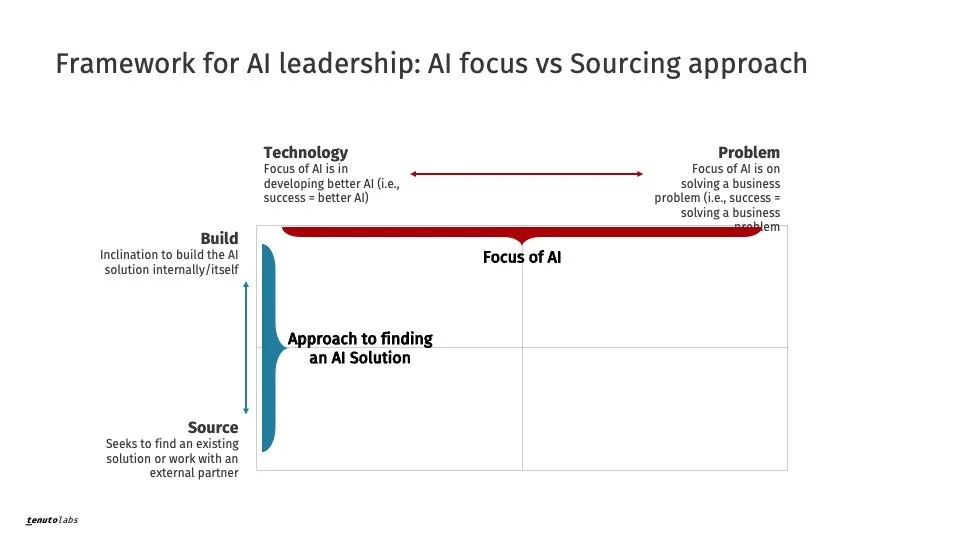What Kind of AI Leader Does Your Organization Really Need?
Applied and Generative Artificial intelligence isn't just reshaping industries, it is changing how businesses fundamentally operate. While many organizations recognize the importance of AI, not all clearly understand how their strategic approach aligns with their actual business needs. To effectively navigate this transformative technology, executives must thoughtfully reflect on their AI strategy and, crucially, the type of leadership required to execute it.
Understanding where your organization sits within this framework can provide valuable clarity about your strategic direction and guide essential leadership decisions. Unlike the adoption of cloud computing, which primarily drove efficiency through standardized infrastructure and reduced expenditures, AI enables efficiency and innovation across diverse, often non-standardized enterprise functions. This capability unlocks entirely new sets of value levers, demanding a more nuanced and deliberate approach to leadership planning. Companies need to thoughtfully consider, strategically plan for, and proactively execute on evolving their leadership style to match the unique opportunities and complexities of integrating artificial intelligence.
To begin, it's helpful to think of AI strategies along two critical dimensions
Figure 1: Tenuto Labs matrix on AI focus vs. sourcing
Technology vs. Business Problem Focus
Technology-Focused: These organizations view AI primarily as an opportunity to advance technological innovation. They invest in pioneering new machine learning techniques and are driven by breakthroughs in AI itself.
Business Problem-Focused: These businesses leverage AI to directly solve tangible business challenges. For them, AI is less about innovation for its own sake and more about practical, measurable outcomes.
Build vs. Source Orientation:
Building AI Internally: Companies with this orientation invest heavily in R&D, crafting bespoke AI solutions in-house to achieve competitive differentiation or unique strategic goals.
Sourcing AI Externally: These organizations prefer to harness existing external AI solutions, leveraging third-party expertise to quickly drive efficiency and scale.
Understanding where your organization sits within this framework can provide valuable clarity about your strategic direction and guide essential leadership decisions.
Decoding the Four AI Leader Archetypes
Within this framework, four distinct AI leadership archetypes emerge, each uniquely suited to different strategic contexts:
Inventor (Technology-Focused + Build):
Inventors are driven by the ambition to push the frontiers of AI technology. They thrive in organizations deeply committed to cutting-edge research, experimentation, and technological breakthroughs. Inventors don't merely follow existing AI trends—they create them.
Tinkerer (Business Problem-Focused + Build):
Tinkerers are practical innovators. They custom-build AI solutions tailored specifically to solve immediate and significant business challenges. Constant experimentation and iterative improvement define their approach, always optimizing solutions to achieve tangible business outcomes.
Integrator (Technology-Focused + Source):
Integrators excel in rapidly adopting external AI innovations. These leaders balance technical depth with pragmatic execution. Their strength lies in recognizing valuable external technologies and seamlessly integrating them to accelerate organizational AI maturity.
Product Manager (Business Problem-Focused + Source):
Product Managers are strategic orchestrators who leverage existing AI technologies to address clearly defined business needs. They excel at driving adoption, scaling solutions quickly, and effectively managing third-party AI tools to maximize immediate business impact.
Figure 2: Tenuto Labs AI leadership archetypes
The key question for every executive team is this: Does your organization's AI strategy match your chosen leadership archetype, and are you prepared to evolve your current leadership orientation if needed? Misalignment between your strategic orientation and leadership archetype can lead to wasted resources, mismanaged expectations, and missed opportunities. Organizations must regularly reassess their strategic needs and proactively adapt their leadership approach to effectively harness AI’s evolving potential.
Consider the following questions:
Does our current AI strategy clearly align with our primary business objectives?
Which AI leadership archetype best describes our current leaders?
Are we investing too heavily in custom AI builds when existing external solutions might suffice? Or conversely, are we sourcing externally when differentiated in-house solutions could provide strategic advantages?
The most successful companies thoughtfully align their AI strategies with their leadership archetypes. As you reassess your organization's position, consider whether your current approach fully leverages AI's potential. Are you building when you should source, or innovating technologically when business-focused practicality might better serve your goals?
AI is a powerful tool—but its effectiveness depends fundamentally on clear strategic direction and the right kind of leadership to guide it. Evaluate your current alignment thoughtfully, and position your organization to not just survive but thrive in the rapidly evolving AI landscape.


